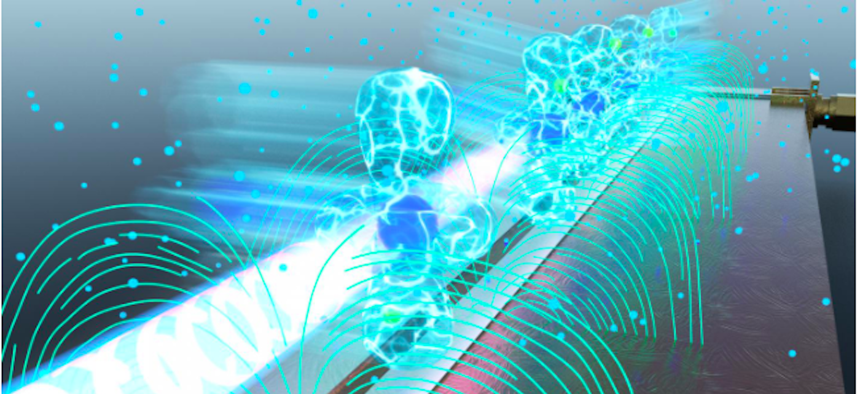
Researchers excite Rubidium atoms to high-energy Rydberg states. The atoms interact strongly with the circuit's electric fields, allowing detection and demodulation of any signal received into the circuit. US ARMY RESEARCH LAB
US Army Creates Quantum Sensor That Detects Entire Radio-Frequency Spectrum
Breakthrough could help the military fight in the electronic spectrum.
A new sensor that can detect the entire radio spectrum could play a big role in the future of electromagnetic warfare and communications.
In January, David Meyer, Paul Kunz, and Kevin Cox with the Army Research Lab published a new paper describing how they used atoms in a quantum state called a Rydberg state to detect electromagnetic emissions up to 20 GHz. That includes the frequencies that carry Bluetooth, WiFi, and other communication methods.
In their experiments, a laser excites rubidium atoms in a vacuum chamber, forcing them into a Rydberg state.
“Rydberg states are highly sensitive to fluctuating electric fields that make up the radio waves. So when radio waves are present, the quantum states themselves fluctuate,” Cox told Defense One in an email. “The device collects input radio waves into a microwave circuit board, and uses a special technique to hone in and boost the sensitivity to targeted regions of the [radio-frequency] spectrum.”
A super-sensitive radio sensor could better help protect communications equipment from jamming or other forms of electromagnetic interference or possibly help operators find devices using the radio spectrum to communicate. But the Army Research Lab sensor is still too big and power-hungry to be deployed, says Cox, so more work is needed to shrink it and improve performance.
The sensor is an example of how quantum science will create new tools for the military. Perhaps the best-known is quantum computing, which may one day permit vastly better communications, codemaking, and codebreaking. In the nearer term are applications being studied by the Army Research Lab, including sensing and atomic clocks for precise navigation and timing without GPS.
Cox said these applications take advantage of a different aspect of quantum science that he called “identicalness.”
“Quantum identicalness is the attribute that quantum particles are all fundamentally identical. This phenomenon enables quantum detectors and sensing devices, like our Rydberg sensor,” said Cox. “The full frontier of quantum technology is still largely unexplored. We look forward to more paradigm-shifting breakthroughs in the near future.”




